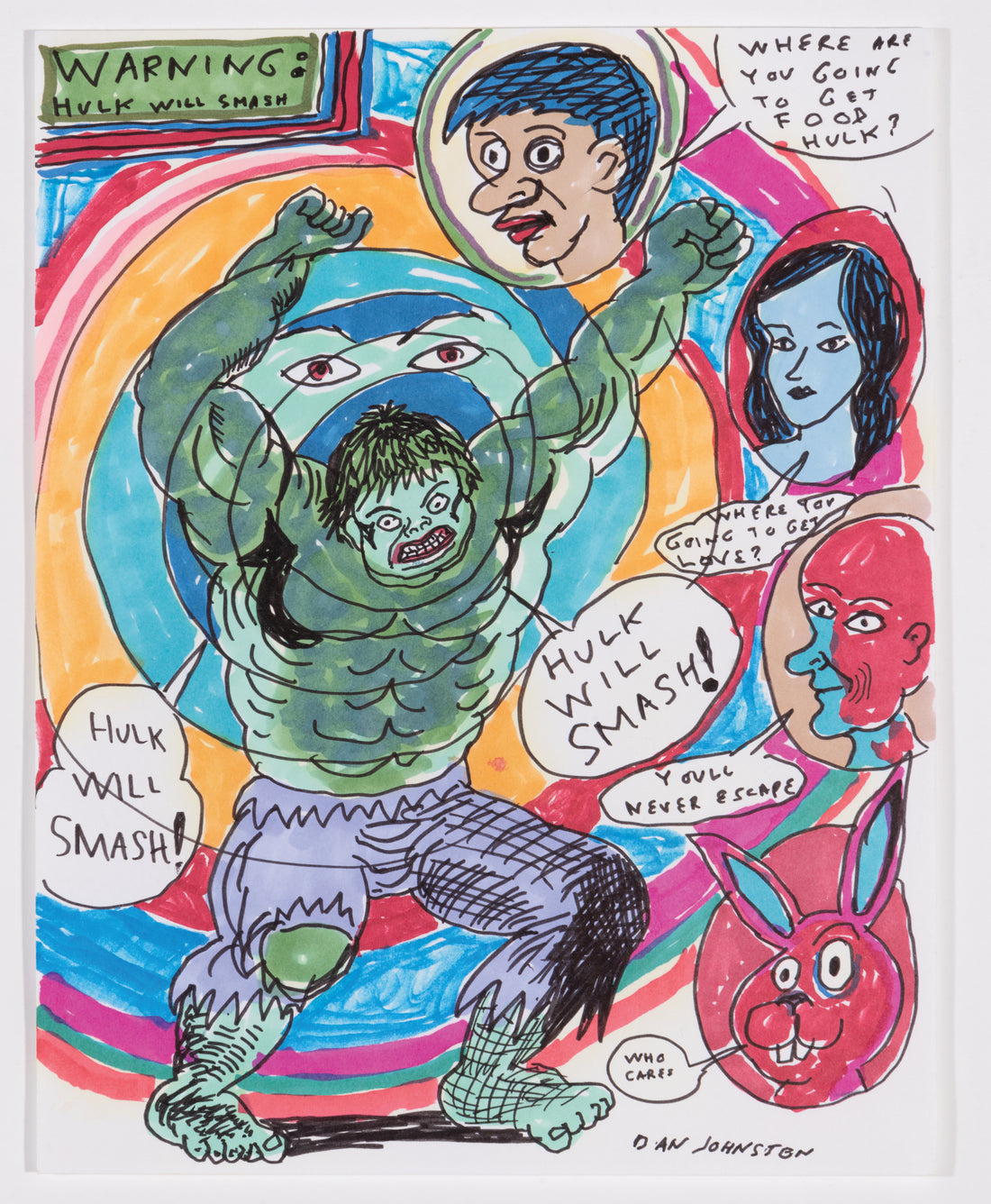First published: Spring 2022
US artist Daniel Johnston achieved cult status with his deeply personal and honest drawings and music
Singer-songwriter and self-taught visual artist Daniel Johnston (1961–2019) was a cult figure both in the alternative music scene and the contemporary art world. He had a big, international following of admirers, some of them famous. An unlikely celebrity, Johnston produced art and music until his untimely death at the age of 58. He created prolifically, compulsively – drawings, album covers, collages, songs – pulling inspiration from all areas of popular culture, from comics to adverts, as well as from his own life experiences and related feelings.
Born in Sacramento, California, Johnston grew up in New Cumberland, West Virginia, the youngest of five siblings. He recalled first making drawings in a cartoonish style when he was three years old, and then composing music from around the age of nine. As an adult, after experimenting with psychedelic drugs, he was diagnosed with bipolar disorder and was then institutionalised intermittently for extended periods of time.
 Who is the Desperate Heart of Daniel Johnston?, 1994
Who is the Desperate Heart of Daniel Johnston?, 1994
all images: ink and marker on paper, 8.5 x 11 in. / 21.5 x 28 cm, courtesy: The Daniel Johnston Trust, unless otherwise stated
In the documentary film My Dinner with Daniel (1988), Johnston says that he wasn’t really passionately into music until high school, when he discovered The Beatles and decided he wanted to be one. He identified with the character Sergeant Pepper because he led the Lonely Hearts Club Band. In a later interview, Johnston reflected on the onset of his mental illness, “When it happened in Junior High, it hit me like a ton of bricks. I was a loner. I turned to art. I just went to the library and looked at books and listened to a ton of records. I just had to be alone, as if I was dead.” His 1978 drawing Sgt Pepper presents a dismembered head with a sardonic smile.
After dropping out of college, Johnston went to live with his brother Dick in Houston and got a job at Astroworld, a local amusement park. He would stay up all night writing songs in the garage, which drove Dick nuts. He wanted to send Johnston home to their parents, but his sister took him in – until he drove her nuts too. Before she could ship him home, he ran away, bought a moped and got a job at a concession stand selling corn dogs in a travelling carnival show. His family had no idea where he was. Johnston went on to draw Speeding Motorcycle (1984) in which a character speeds away from death – represented by two skulls – while pleading, “Get away from my life!”.
 My Nightmares, 1980
My Nightmares, 1980
Milkovisch was an upholsterer who worked on railroad cars, a practical man who decorated his house intuitively on his days off and after his retirement. He told anyone who asked about his creation that he did it because he hated mowing the lawn and painting the house. But he loved to drink beer – whatever was on special.

Hulk Will Smash, 2000
The artist-musician first acquired a fan base in Austin, Texas, in the 1980s by handing out cassette tapes of his simple, heartfelt songs while working at McDonalds, and by performing at local indie music venues. His fame grew in 1985 when he appeared on MTV’s The Cutting Edge – a music programme featuring lesser-known acts – and considerably more when Nirvana's Kurt Cobain famously wore a t-shirt featuring Johnston’s drawing of a big-eyed frog, at the 1993 MTV Video Music Awards. In 1985, two of his songs were included on the soundtrack of Larry Clark’s film Kids.
The artist’s creative beginnings, rise to fame and ongoing struggles with mental illness were the subject of the 2006 documentary The Devil and Daniel Johnston which showed that music and art were the only true ways for him to express himself. While many of his songs were sad remembrances of unrequited love, his drawings usually revealed who he wanted to be or how he thought he was being treated. His obsessively produced, stream-of-conscious pen and marker works were regularly exhibited, including in a group show at Dinter Fine Art in New York in 2005, solo shows at the Clementine Gallery and the Whitney Biennial in New York both in 2006, and at the 2008 Liverpool Biennial in the UK.
by PAUL LASTER
This is an article extract; read the full article in Raw Vision #110




